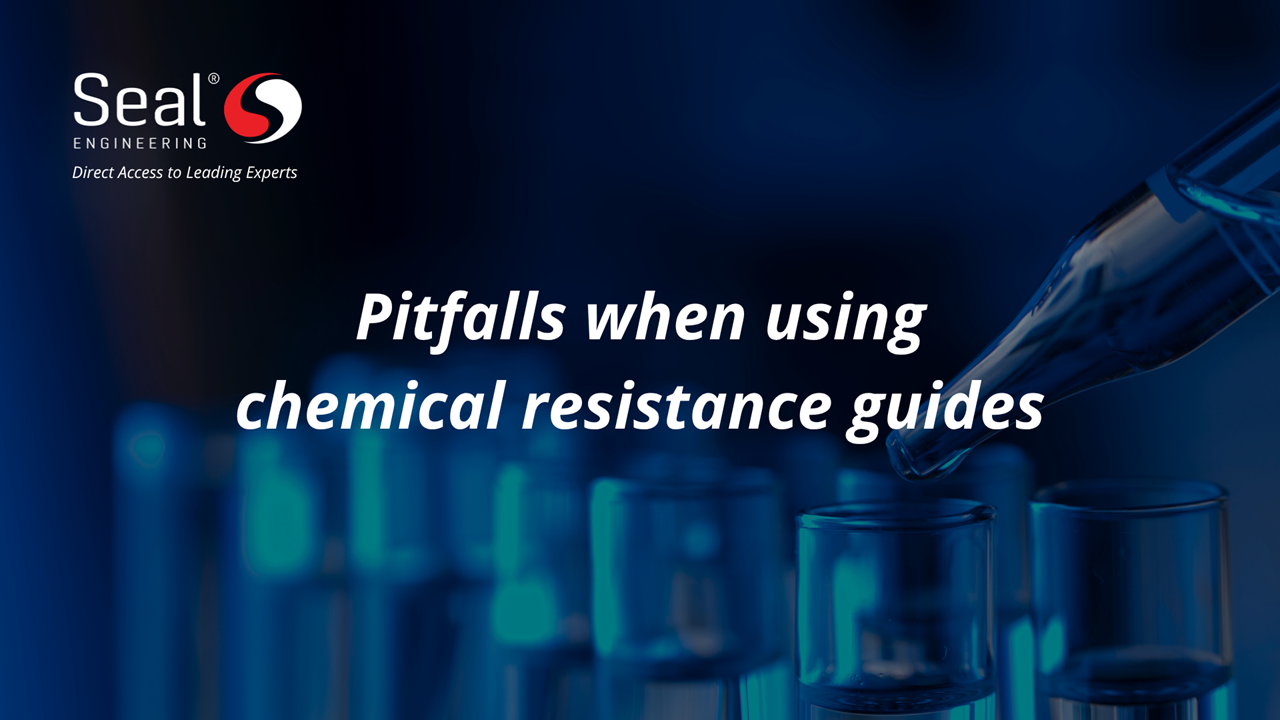
Pitfalls when using chemical resistance guides
1 Abstract
Chemical compatibility of your elastomer compound is absolutely crucial to secure safe and reliable function of your application. When evaluating compatibility, the difference between compatibility of a polymer vs compound is often overlooked and may cause serious failures. Likewise, the difference in compatibility between all the compounds within a given group of elastomers.
Being aware of this difference is of outmost importance when screening and finally selecting your elastomer compound. This paper gives you some guidelines on how to avoid costly mistakes when assessing the compatibility of elastomers.
2 Background
An elastomer compound, often referred to as “rubber”, consist of several ingredients besides the polymer; typically reinforcing components, cure package and processing aids which as a whole is referred to as “fillers”. These fillers can potentially have a significantly different chemical resistance to a given chemical, a point often overlooked.
For the main elastomer groups such as NBR, HNBR, FKM, FEPM and FFKM there are numerous types of polymers within each group and there are almost an infinite number of compounds with different combinations of polymers and fillers.
Nevertheless, when looking in your typical chemical resistance guide you see for instance “FKM” and a rating versus different chemicals. Is the rating given on the basis of the polymer or the compound? Considering on a compound basis, you basically know nothing about the ingredients that make up a given FKM or others. Assuming a “typical compound”, if this even makes sense, can prove costly.
3 How to proceed
3.1 Deciding factors for chemical compatibility
Firstly, you need to be aware of the basic factors deciding chemical compatibility for a polymer or compound towards a given chemical composition:
- Temperature
- Concentration (when relevant)
- Time
These three factors are not necessarily stated in a chemical resistance guide, which potentially could be misleading. Typically, a compound can withstand exposure to a given chemical at relatively low temperatures, but not for higher temperatures even though this higher temperature is within the “maximum operating temperature” stated in the datasheet.
Concentration is equally important where relevant. A given compound could be compatible for a low concentration, but not a higher concentration. All elastomer materials deteriorate over time and the required lifetime of your application or elastomer compound within should be taken into account. In many chemical resistance guides these factors are not stated, or maybe only for instance concentration is stated. This leaves a lot of room for uncertainty and further investigation is advised.
Secondly, compatibility is not a defined term, various guides use different criteria for the change or degradation in material properties leading to a given rating or assessment. For instance, this could be a given amount of swelling, change in elongation or tensile properties.
For critical applications a more precise knowledge of the changes in material properties is valuable.
3.1.1 Polymer and compound
When looking at good guides there are still some pitfalls you need to be aware of. As mentioned, the difference in compatibility between polymer and compound could be substantial. This also applies for compounds. In most cases it is fair to assume that the rating is based on a typical compound, which in many cases could be sufficient. However, you do not really know, and especially so if the chemical is believed to be “aggressive”.
The term “typical compound” can be very misleading and lead to wrongful selection of elastomer. Polymer is not straightforward either. For instance, FKM is divided into five different types of polymers with distinct differences in chemical resistance for given chemicals and temperature.
If a guide provides a rating for FKM only, what should you make of it? The rating might be poor based on a FKM type 1, whereas a different type should be considered compatible.
3.1.2 When can guides be trusted
As described so far, most guides have shortcomings and should not be trusted in many cases. However, there are guides that will provide trustworthy information. Compatibility guides for polymers could be trusted provided sufficient level of detail. Keep in mind that you still need to know the impact of fillers to reach a reliable conclusion.
Compatibility guides which are compound specific can be considered trustworthy provided sufficient details regarding beforementioned factors. In general, chemical resistance guides should only be used for initial assessment for the selection of a polymer or compound. Further investigation should be performed until you have assurance of the compatibility for specific compound.
4 Case story
Below chart shows weight change of various fluoroelastomers exposed to 28% HCl aq for 70 hours @ 120° C. The actual compounds are not disclosed, but one can clearly see that within the various FKM’s there are huge differences. Some can be considered compatible, whereas others are clearly not. Same can be seen for the two compounds based on ETP – polymer.

The difference in performance is most likely not so much linked to the polymer, but rather that the poor performing compounds contain metal oxides which readily react with HCl.
How should you be able to extract this information from a chemical resistance guide stating only FKM and maybe more importantly, what would the rating be?
5 Pro Tip
For critical applications it is recommended to perform dedicated material testing to assess the compatibility of a given compound. Make sure that test conditions are relevant for your application, especially considering temperature and service life.




